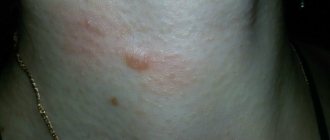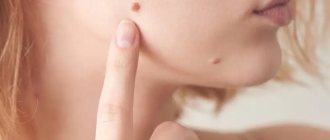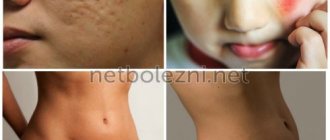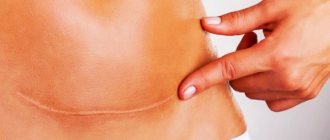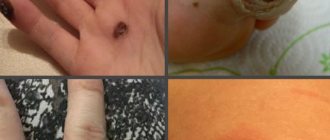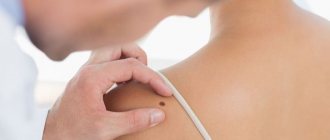03/07/2018 There is a risk of a scar appearing on the skin after surgery. The smaller the area and depth of the damage, the less likely it is to occur. Is it possible to guarantee that a scar will not appear or to cure it completely?
This is an article by Mikhail Gusarov, member of the European Academy of Dermatology and Venereology (EADV), International Dermatoscopy Society (IDS), author of more than 10 scientific publications.
What determines the risk of scarring?
The appearance of a scar and its nature depends on a number of factors:
- Depth and area of damage: if they are small, a scar may not appear at all.
- Tissue healing abilities.
- The presence of chronic diseases (for example, diabetes).
- Time for complete healing of the wound (it may increase if the wound has become infected).
The process of complete wound healing, which lasts for 21 days, ends with pathological scarring in only 33% of cases. If the process lasts more than 21 days, the probability increases to 78%.
Contraindications for laser removal
Laser procedures are not performed under the following conditions:
- oncological diseases of any localization;
- HIV, MSID, viral hepatitis, diabetes mellitus;
- pregnancy and lactation;
- exacerbation of chronic diseases;
- infectious or inflammatory diseases;
- mental disorders;
- severe damage to the heart and lungs;
- organ failure;
- bleeding disorders;
- skin photosensitivity;
- autoimmune systemic diseases;
- inflammatory skin diseases, exacerbation of herpes infection.
If you need to diagnose or remove a wart, contact a medical professional. The operations are carried out at a high professional level using modern laser technology of the latest generation, which eliminates the risk of complications or relapse. Laser removal of warts is carried out at any convenient time on an outpatient basis, which will not affect your usual lifestyle. You can make an appointment by calling the center or leaving a request on the website.
How does a wound heal?
The following phases of wound healing are distinguished:
- Inflammation. It begins immediately after the injury and lasts about 2-3 days, during this phase it is necessary to clean the wound and carry out anti-infective measures.
- Proliferation. From 3 days to 2 weeks. It is necessary to maintain the absence of infection and adequate hydration.
- The appearance of a scar. From 2 weeks to several years. During this phase, measures are taken to correct the scar depending on its type. [12]
Is a scar a reason to go to the doctor?
Reasons for visiting a doctor:
- aesthetic dissatisfaction;
- itching and pain in the scar area;
- the formation of deformities and contractures, which can lead to disability.
If scar tissue begins to develop pathologically and causes a keloid scar, it is better to consult a doctor.
There are factors that increase the risk of developing a scar:
- genetic predisposition;
- race (black patients are more likely to develop keloids);
- localization of injury (when removing tumors in the chest, neck and shoulders, the likelihood of keloid scars is higher);
- age (the formation of keloid scars is typical for young people). [3]
Before and after. How we remove scars
Preparation for the procedure
Before laser removal, a thorough examination and examination of the tumor is carried out to ensure its benign nature. If the tumor contains malignant cells, the laser cannot be used. Wart removal will be carried out using a classic operation with removal of the tumor and part of the healthy tissue. Laser surgery is not performed if during the operation it is necessary to take biological material for subsequent research.
In addition to examining the mole, the doctor surveys the patient about possible contraindications to the procedure, and also conducts a number of studies (blood tests).
How to prevent the appearance of a keloid scar?
There are several ways to prevent the appearance of a keloid scar.
- If surgical excision of the tumor is performed, techniques that minimize tension on the wound edges should be used during suturing.
- Mechanical stabilization - the use of special silicone plates or the use of silicone-based gels.
- The use of various medications containing flavonoids - substances obtained naturally from various plants (for example, onion extract). However, data on the effectiveness of this group of drugs is contradictory.
- Pressure therapy (compression) – within 15–40 mm Hg. Art. for 23 hours a day for 6 months. Data on the effectiveness of this method are also conflicting.
- Glucocorticosteroids (GCS) - can be used as creams or ointments in the initial stages of scar formation and to prevent its formation, as well as in the form of injections into scar tissue. [4]
Removal of tumors
Warts can disappear on their own. And subject to strong immunity. But in our life, good health is rather rare. Not everyone can sit and wait for them to disappear.
Methods of disposal:
- ointments and gels;
- laser removal;
- surgical intervention;
- cryodestruction;
- chemical method;
- electrocoagulation;
- thermocoagulation;
- ointments based on salicylic acid.
Treating the growth with a special compound will help get rid of this growth quickly and painlessly.
A wart does not always go away without a trace. And most often it can leave marks and scars even after laser exposure. The result may not be what you expected.
Helps avoid relapse in the near future. But this method also has a significant disadvantage - the appearance of scars. Therefore, it is not recommended in cases of removal of bumps on the face and visible places.
The essence of the procedure is the effect of low temperatures on the areas affected by warts; as a rule, liquid nitrogen is used for cryodestruction. But it may take several sessions to achieve the desired effect. And the skin will need time to recover. Traces of neoplasms remain minimal.
Special preparations are used, but traces of warts remain noticeable.
Applying electric current to warts. To carry out the procedure, a device is used that generates high-frequency electricity.
Cauterization (coagulation) of a damaged area of skin with a special device - a thermal cautery, which has a heating metal tip. The method involves exposing the affected area to high-frequency waves.
It is believed that such drugs are effective for plantar wart scars. But this method takes several months and the result will be unpredictable. Something similar to fortune telling with a chamomile.
What if a scar appears?
Once scar tissue has formed, unfortunately, it will not be possible to completely get rid of it. All medical actions in this case will be aimed at minimizing the manifestations of the scar. The following methods are used to treat formed keloids:
- GCS injections are a popular and effective method for treating keloid and hypertrophic scars. A GCS solution is injected into the scar tissue 1–2 times a month until the expected results appear. Unfortunately, with excessive use of the drug, skin atrophy may develop at the injection site, telangiectasia or an atrophic scar may appear. [4]
- Surgical excision of the scar - you should not resort to this method as the only remedy, since it always ends in a relapse that exceeds the existing scar in area. This method can be resorted to after previous long-term therapy carried out in various ways. [4]
- Cryotherapy is the treatment of scars with liquid nitrogen. There are various methods of its use: spray, contact method and intralesional cryoprobe. The latter method is more effective. In addition, the combination of cryotherapy with GCS injections gives the best result compared to others. [4]
- Laser treatment – various lasers are used. Nd:YAG laser with a wavelength of 1,064 nm is used to target the vessels of scar tissue. In addition, CO2 and Er:YAG lasers are actively used in fractional mode. But it is not recommended to use ablative lasers (CO2 and Er:YAG) as the only treatment method, since in this case there is a high probability of relapse. [5]
A dye laser (PDL) with a wavelength of 585 nm is also considered effective. [6]
There is evidence of the effective use of CO2 laser in fractional mode during surgery to improve the cosmetic outcome of healing. [7]
- Ointment with 5-fluorouracil for the treatment of scars, but it is not sold in Russia. [4]
- Botulinum toxin type A is used to weaken the tension of the wound edges by reducing muscle activity. Injections are given immediately after surgery. [8]
- Imiquimod cream is recommended for use after surgical excision of a scar to minimize the likelihood of recurrence. [9]
- Other methods - bleomycin, verapamil, TGF-β, interferon, tacrolimus, sirolimus, tamoxifen, epidermal growth factor, retinoic acid, tamoxifen and other drugs are also considered effective for the treatment of scars. [10]
Unnecessary marks
Removal of a mole (nevus) should always be preceded by a consultation with a dermatologist or oncodermatologist. And after the operation, it is highly advisable to conduct a histological examination of the removed tissue, since some moles (especially those that have appeared recently, are irregular in shape, painful, growing) can degenerate into malignant tumors. In addition, the mole often lies deep in the tissues, and, if not completely removed, can “sprout” again.
There are several ways to remove moles: electrocoagulation, laser surgery, cryodestruction, surgery.
Electrocoagulation is the use of high-frequency current to remove a mole. After exposure to current, small and neat scars remain.
When removing moles with a laser, thrombosis of the smallest vessels occurs, which virtually eliminates blood loss. The skin after such an operation quickly regenerates, and the cosmetic effect is quite high. But the laser can only be applied to moles that are not in doubt about their benign quality. In this case, it is impossible to analyze the removed tissues.
Traditional surgical section is one of the most common ways to get rid of moles, especially flat ones. True, not only the nevus is excised, but also part of the skin around it. After the operation, you will have to remove the stitches and decide what to do with the resulting scar.
Cryodestruction (burning with liquid nitrogen) is not the optimal solution to the question of how to remove moles. The spread of cold in tissues is difficult to control, so it is easy to injure areas adjacent to the mole. In any case, it is up to the specialist to decide which method to use.
A specialist in the removal of warts, moles, and scars is called a dermatocosmetologist. He must have a higher medical education and undergo specialization in dermatology and dermatocosmetology. It is best if the place where you go about a “skin defect” is a well-known beauty institute or salon with a solid reputation.
After removing moles and warts, a scar (scar) remains on the skin. It is more difficult to get rid of postoperative and post-traumatic scars. It is impossible to completely remove scars, but it is possible to make them less noticeable.
If the mark is very large, the so-called W-plasty and Z-plasty are used. The scar is excised and covered with neighboring tissues - only a thin zigzag line remains.
Flat scars, distinguished only by their whiteness, can be camouflaged cosmetically using micropigmentation (aka tattooing). In a special salon, paint is injected into the scar, matching the color of the skin.
It is more difficult with raised (keloid) scars. Some (usually people with dark skin) have a tendency to form keloids: scars appear as a result of the smallest scratches, and attempts to get rid of them often lead to relapse. In such cases, conventional surgical removal methods are supplemented by radiotherapy, as is the case with tumors. Hormones are injected into scars to stop their growth.
Laser or mechanical resurfacing will save you from not very large scars. True, due to its high cost, it is used mainly for facial enhancement. The laser is used under general anesthesia for 45-60 minutes, the grinding cutter (in combination with cauterization) is used under local anesthesia for 10-20 minutes. But the result will not be assessed immediately: in the first week you will have to get rid of the swelling, and the skin will acquire a finally healthy appearance only after six months.
Much more often, dermatosurgeons have to deal with superficial scars after acne or chicken pox. These are so-called trophic (“pit-shaped”) scars. They are removed using chemical peeling - grinding with special acids. More trouble with deep scars. In such cases, it may come down to tissue transplantation: the scar is removed, and a piece of healthy skin is transplanted in its place, usually from behind the ear.
There are also low-impact ways to get rid of unwanted marks. The bottom of the scar can be “raised” by pumping a filler (implant) under it. The drug is injected into the deepest part of the scar so that it is even with the surface of the skin. The result is immediate, but short-lived: the procedure will have to be repeated in six months or a year. In such operations, preparations based on hyaluronic acid are usually used, which, unlike silicone ones, are perfectly compatible with the skin and do not cause rejection or allergic reactions.
Which method is the most effective?
Unfortunately, there is no most effective treatment for scars. The most effective is considered to be a combination of various methods, which is always selected individually. Injections of corticosteroids into hypertrophic or keloid scars are considered an accessible, effective and inexpensive method.
Atrophic scars are distinguished separately: for their correction, planar ablative lasers, fractional ablative lasers (CO2 and Er:YAG), various combinations of lasers (fractional +PDL, Qsw+fractional lasers), collagen, fillers with hyaluronic acid, PRP therapy, microneedling are used. , peeling and a number of other methods [11, 12]
Previously, the dermabrasion method was used to correct atrophic scars, but now it is practically not used, since it is associated with the risk of side effects: bacterial or viral complications, telangiectasia, hyperpigmentation, a long rehabilitation period, as well as hypertrophic or keloid scars.
Benefits of laser wart removal
Laser removal has many advantages:
- High quality result. During surgery, the tumor is completely removed, there is no risk of relapse.
- Pain and discomfort are minimal or absent. The procedure is performed under local anesthesia.
- Speed of the procedure. Laser destruction of a wart takes no more than 5 minutes.
- Minimally traumatic procedure. The laser beam acts only on the cells of the formation, without affecting nearby tissues.
- Excellent cosmetic effect. After laser removal there are no scars or marks left.
- Versatility. Due to the precision of the laser, this method can be used on any part of the body, including areas with thin and sensitive skin, mucous membranes, intimate area, eyelid skin, etc.
- There is no rehabilitation period. The procedure is performed on an outpatient basis, after which you can lead your normal lifestyle.
- Minimal risk of postoperative bleeding. The action of the laser coagulates blood vessels, which eliminates the risk of bleeding.
How not to treat scars
Incorrect treatment, in addition to wasting money and time, can lead to enlargement of the scar. What could cause this:
- non-compliance with doctor’s recommendations after removal or self-medication;
- traumatization and irritation of the wound can lead to relapse;
- non-compliance with prescribed antiseptic methods;
- removal of the crust that has formed at the site of removal: under it the restoration process is more efficient.
There is not enough information in scientific sources to evaluate the effectiveness of folk remedies in the treatment of scars. From my experience I can say that I have not seen a single patient for whom folk remedies produced any significant positive changes. And in fairness, it’s worth saying that I rarely encounter the use of folk remedies in the treatment of scars.
Bibliography:
- J Am Acad Dermatol. 2016 Apr; 74(4): 607–25; quiz 625–6. doi: 10.1016/j. jaad. 2015.08.070. Wound healing and treating wounds: Chronic wound care and management. Powers JG, Higham C, Broussard K, Phillips TJ.
- J Am Acad Dermatol. 2016 Apr; 74(4): 589–605; quiz 605–6. doi: 10.1016/j. jaad. 2015.08.068. Wound healing and treating wounds: Differential diagnosis and evaluation of chronic wounds. Morton LM, Phillips TJ.
- Ann Hum Genet. 2022 Feb 27. doi: 10.1111/ahg.12245. Gene-based evaluation of low-frequency variation and genetically-predicted gene expression impacting risk of keloid formation. Hellwege JN, Russell SB, Williams SM, Edwards TL, Velez Edwards DR.
- Int. J. Mol. Sci. 2022, 19(3), 711; doi: 10.3390/ijms19030711. Recent Understandings of Biology, Prophylaxis and Treatment Strategies for Hypertrophic Scars and Keloids. Ho Jun Lee, Yong Ju Jang.
- Br J Dermatol. 2011 Nov; 165(5): 934-42. doi: 10.1111/j.1365-2133.2011.10492.x. Laser and intense pulsed light therapy for the treatment of hypertrophic scars: a systematic review. Vrijman C, van Drooge AM, Limpens J, Bos JD, van der Veen JP, Spuls PI, Wolkerstorfer A.
- Laser Ther. 2013 Dec 30; 22(4): 255–260. doi: 10.5978/islsm.13-OR-20 Laser Scar Management Technique. Takafumi Ohshiro, Toshio Ohshiro, and Katsumi Sasaki
- Arch Dermatol. 2011 Sep;147(9):1108-10. doi: 10.1001/archdermatol.2011.248. A randomized split-scar study of intraoperative treatment of surgical wound edges to minimize scarring. Ozog DM, Moy RL.
- Plast Reconstr Surg. 2022 Mar;141(3):646-650. doi: 10.1097/PRS.0000000000004110. Effects of Botulinum Toxin on Improving Facial Surgical Scars: A Prospective, Split-Scar, Double-Blind, Randomized Controlled Trial. Hu L, Zou Y, Chang SJ, Qiu Y, Chen H, Gang M, Jin Y, Lin X.
- Curr Pharm Des. 2017;23(15):2268-2275. doi: 10.2174/1381612822666161025144434. The Effectiveness of Topical Anti-scarring Agents and a Novel Combined Process on Cutaneous Scar Management. Fang QQ, Chen CY, Zhang MX, Huang CL, Wang XW, Xu JH, Wu LH, Zhang LY, Tan WQ.
- Dermatol Surg. 2022 Jan; 43 Suppl 1:S3-S18. doi: 10.1097/DSS.0000000000000819. Keloids and Hypertrophic Scars: Pathophysiology, Classification, and Treatment. Berman B, Maderal A, Raphael B.
- Clinical and Experimental Dermatology, June 1, 2013. Combination of intense pulsed light and fractional CO2 laser treatments for patients with acne with inflammatory and scarring lesions. B. Wang, Y. Wu.
- Skinmed. 2022 Aug 1; 15(4):271-276. eCollection 2022. Techniques for Optimizing Surgical Scars, Part 1: Wound Healing and Depressed/Atrophic Scars. Konda S, Potter K, Ren VZ, Wang AL, Srinivasan A, Chilukuri S.
